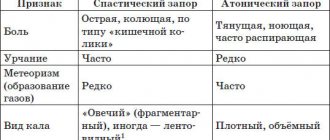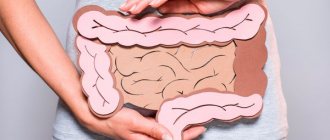Diarrhea is loose or watery stool that occurs three or more times a day or more often than usual for a particular person. It is usually a symptom of a gastrointestinal infection, which can be caused by a variety of bacteria, viruses and parasites. The infection is spread through contaminated food or drinking water, or from person to person as a result of poor hygiene.1 If you have diarrhea, you should change your diet to include foods that have a beneficial effect2 on the body during this period.
Acute diarrhea
A very common condition, usually resulting from eating food or water contaminated with bacteria, their toxins, viruses and protozoa. Infectious diarrhea is usually short-lived, so an infectious cause is rarely identified in patients with diarrhea for more than 10 days. Alcohol intoxication, various drugs, including antibiotics, cytotoxic drugs, non-steroidal anti-inflammatory drugs, can cause acute diarrhea.
Traveler's diarrhea is also recognized
. It develops in the first days in people traveling to exotic regions of the planet other than their own and is associated with the consumption of food and water with a different qualitative and quantitative composition of non-pathogenic microbial flora.
We can talk about the acute nature of diarrhea if the duration is no more than 3 weeks; otherwise, diarrhea is considered chronic.
Diarrhea due to diseases of the digestive system
In the practice of a gastroenterologist, diarrhea is one of the most common symptoms, which can be a sign of many different pathological conditions. From the point of view of existing diagnostic criteria, diarrhea is a pathological condition that implies a change in both the shape of feces and the frequency of bowel movements. First of all, this is an increase in bowel movements (more than 3 times per day), in addition, the release of liquid feces (watery or mushy) with a volume of more than 200 ml.
There are acute and chronic diarrhea. Symptoms of acute diarrhea can last from a few days to 4 weeks. In most cases, episodes of acute diarrhea are associated with viral, bacterial or parasitic infestations. In chronic diarrhea, symptoms persist for more than 4 weeks.
Diseases of the digestive system are usually accompanied by chronic diarrhea. These include: atrophic gastritis with reduced secretory function of the stomach, postgastroresection and postvagotomy disorders, chronic pancreatitis with exocrine pancreatic insufficiency, biliary dysfunction and postcholecystectomy syndrome, chronic liver diseases, pathology of the small intestine, accompanied by the development of malabsorption syndrome, bacterial contamination of the small intestine, ulcerative colitis and Crohn's disease, tumors of the small and large intestine, ischemic and pseudomembranous colitis, functional bowel diseases, hormonally active tumors of the gastrointestinal tract (GIT).
There are four pathogenetic variants of diarrhea.
- Secretory diarrhea This type of diarrhea is characterized by frequent loose stools of more than 1000 ml per day. It occurs primarily in bacterial and viral infections (cholera, salmonellosis, rotavirus and HIV infections), as well as in hormonally active tumors - apudoms (gastrinoma, VIPoma, carcinoid).
- Osmotic diarrhea The volume of liquid feces ranges from 500 to 1000 ml per day. Osmotic diarrhea occurs in chronic pancreatitis with exocrine insufficiency, fermentopathy, celiac enteropathy, Whipple's disease, dumping syndrome, bacterial contamination of the small intestine, and the use of osmotic laxatives.
- Exudative diarrhea The volume of liquid feces is 200–500 ml per day. This type of diarrhea develops with ulcerative colitis, Crohn's disease, ischemic and pseudomembranous colitis, colon tumors, radiation colitis, dysbiosis, colon diverticulosis with diverticulitis.
- Motor diarrhea As a rule, with this form of diarrhea, polyfecal matter is not observed: the volume of liquid feces per day is no more than 200–300 ml. Motor diarrhea is typical of irritable bowel syndrome (IBS), functional diarrhea, intestinal dysbiosis, and is observed in patients after vagotomy.
Quite often, chronic diarrhea is a clinical sign of malabsorption syndrome. This term has been widely used in foreign literature for many years. Malabsorption syndrome is characterized by a disorder of absorption of nutrients in the small intestine and a disorder of metabolic processes. The development of this syndrome is based not only on morphological changes in the mucous membrane of the small intestine, but also on disturbances in the enzyme systems of the gastrointestinal tract, intestinal motor function, as well as disorders of specific transport mechanisms.
In domestic clinical practice, the term “chronic enteritis” is more often used. However, histological examination does not reveal chronic inflammation in the majority of such patients.
Malabsorption syndrome can be caused by damage to any of the layers of the wall of the small intestine. Absorption disorders can be partial (the absorption of individual nutrients is difficult) or general (the absorption of all products of food digestion is difficult).
There are primary and secondary malabsorption. Primary malabsorption is based on enzymopathies, hereditary changes in the structure of the absorptive epithelium (celiac disease, disaccharide intolerance, collagen sprue, tropical sprue).
Secondary malabsorption is caused by damage to various layers of the wall of the small intestine, as well as other organs (Whipple's disease, Crohn's disease, chronic enteritis, intestinal resection, pancreatic pathology, gastric resection, poisoning, radiation damage, amyloidosis, infectious and viral diseases, immunodeficiency states).
Let us recall the functional morphology of the small intestine. It consists of four membranes: mucous, submucosal, muscular and serous.
The mucous membrane forms spiral or circular folds, due to which the absorption surface increases by 2–3 times. In addition, the circular arrangement of the folds promotes mixing of the chyme and its retention in the resulting niches. There are many villi located on the surface of the mucosa. They are represented by protrusions of the lamina propria, covered with columnar epithelium, goblet cells, single-layer bordered epithelium, 90% of which are enterocytes with a brush PIC-positive border formed by microvilli. On the surface of each enterocyte there are 1500–2000 microvilli, which increase the absorption surface of the intestine by 30–40 times (up to 200 m2). The brush border is characterized by high alkaline phosphatase activity. Goblet cells are located among the bordered epithelium.
At the base of the crypts there are single cells with large eosinophilic granules. These are Paneth cells, which resemble pancreatic acinar cells. There is evidence that Paneth cells must compensate for the impaired exocrine function of the pancreas (contain trypsin, phospholipase, trypsin inhibitor). In addition, Paneth cells contain lysozyme, immunoglobulin A, i.e. perform a bactericidal function.
The epithelial cells covering the areas of the intestine occupied by Peyer's patches differ in structure and function; they are called membranous cells (M cells). There are few microvilli on them, and enzyme activity is lower. M cells capture and transport antigens from the intestinal lumen to the lymphoid tissue. In addition, there are many endocrine cells in the small intestine.
Metabolic disorders in malabsorption syndrome include metabolic disorders: protein (loss of body weight, hypoproteinemia, hypoalbuminemia, edematous-ascitic syndrome, imbalance of amino acid concentrations in the blood serum, increased loss of protein in feces - creatorrhoea), carbohydrate (impaired hydrolysis and absorption of carbohydrates, hypoglycemia, flat glycemic curves, excessive formation of organic acids in the intestines) and lipid (weight loss, decreased lipid levels in the blood, steatorrhea due to the increased content of fatty acids and soaps in the feces). The absorption of Ca++, Mg++ and vitamin D is closely related to the absorption of fats. A decrease in the absorption of Ca++ and Mg++ is due to the formation of insoluble calcium and magnesium soaps through the interaction of these salts with fatty acids not absorbed in the intestine. Vitamin D deficiency can be explained by its dissolution in unabsorbed fats.
With malabsorption, symptoms associated with a deficiency of electrolytes, microelements, and vitamins are observed. Pluriglandular insufficiency may develop (pituitary-adrenal, sexual disorders, decreased thyroid function). On the contrary, functional intestinal diseases are never accompanied by metabolic disorders, and the patient’s general condition does not suffer. However, making a diagnosis of a functional disorder (IBS, functional diarrhea) is always a very responsible and serious task, requiring the exclusion of organic intestinal pathology, infectious and helminthic diseases. In the differential diagnosis, the so-called “alarm symptoms” (weight loss, fever, blood in the stool, anemia, family history of colon cancer, antibiotic treatment) should be excluded. There are diagnostic criteria that allow you to differentiate between IBS and organic gastrointestinal diseases:
- short medical history (less than 2 years);
- persistent diarrhea;
- diarrhea at night;
- acute onset of diarrhea;
- loss of body weight (5 kg or more);
- accelerated erythrocyte sedimentation rate;
- low blood hemoglobin level;
- low blood albumin level;
- positive test for laxatives in urine;
- polyfecal;
- pathology found in intestinal biopsy;
- pathology detected during sigmoidoscopy.
Modern diagnosis of digestive diseases associated with diarrhea is quite complex and includes, in addition to clinical ones, a large list of laboratory and instrumental methods.
First of all, this is a general clinical analysis of blood and urine, scatological examination, biochemical blood test (total protein and protein fractions, glucose, blood lipids, electrolytes, serum iron, liver tests, pancreatic enzymes), ECG, microbiological examination of stool to exclude the infectious origin of diarrhea, determination of elastase-1 in feces. To assess the acid-producing function of the stomach, pH measurements are performed. X-ray examination includes examination of the stomach and passage of barium through the small intestine, and, if necessary, irrigoscopy.
The diagnostic standard for diarrhea also includes ultrasound of the digestive organs (liver, biliary tract, pancreas, intestines). In case of chronic diarrhea, esophagogastroduodenoscopy is performed with a biopsy from the descending duodenum or proximal jejunum for histological examination, qualitative determination of lactase enzyme activity in the biopsy specimen, bacteriological examination (to diagnose bacterial contamination of the small intestine); to exclude pathology of the large intestine - colonoscopy with examination of the terminal part of the small intestine. In recent years, video capsule studies have been used to assess the condition of the intestine (especially the small intestine).
A hydrogen breath test using gas analyzers allows you to determine excessive bacterial growth (bacterial contamination) in the small intestine, fermentopathy, and motor function of the small intestine.
Currently, a respiratory carbon test with the C13 isotope has appeared to assess the functional state of hepatocytes, exocrine function of the pancreas, identify enzymopathies, bacterial contamination of the small intestine and motor function of the gastrointestinal tract. In difficult diagnostic cases, to exclude immunodeficiency conditions, the patient’s immune status is assessed (the main subpopulations of immunocompetent cells, immunoglobulins in the blood serum). To assess local immunity, acute-phase proteins, albumin, α-1-antitrypsin, and secretory immunoglobulin A are determined in the perfusate of the small intestine. The standard method recommended by WHO for assessing the permeability of the intestinal barrier is the enzyme-linked immunosorbent method with a chicken egg ovalbumin load.
In the diagnosis of celiac enteropathy, in addition to histological examination of a biopsy of the small intestinal mucosa, it is necessary to determine antibodies to gliadin, tissue transglutaminase and determination of antiendomysial antibodies in the blood serum.
In addition to X-ray examination, assessment of intestinal motor function can also be carried out using the radionuclide method after breakfast with a Tc99 radiolabel (scintigraphy of the stomach, small and large intestine).
Treatment of chronic diarrhea syndrome in diseases of the digestive system should be comprehensive, ensuring the normalization of the patient’s nutritional (trophological) status and the development of adaptation-compensatory processes, which helps improve the quality of life.
The first and leading should be the prescription of diet therapy . Nutritional therapy for diarrhea includes the administration of a standard diet, and, if necessary, elimination diets and enteral nutrition mixtures.
The standard diet option is characterized by a high protein content (110–120 g), physiological norms of fat (90 g) and carbohydrates (300–350 g), vitamins and minerals in the daily diet. The energy value is 2500–2600 kcal. Culinary processing of products is provided, allowing for maximum sparing of the mucous membrane of the small intestine and slowing down the passage of food. Meals are fractional, foods with coarse fiber, milk, canned food, spicy and salty foods, and alcoholic drinks are excluded.
Elimination diets involve excluding milk for lactase deficiency, prescribing a gluten-free diet and excluding products containing “hidden” gluten (canned food, sausages, kvass, gin, products with gluten-containing stabilizers) for celiac enteropathy.
Prescribing enteral nutrition mixtures to patients with clinical manifestations of malabsorption syndrome and underweight is necessary in all cases where a standard diet fails to provide nutritional support. Standard, semi-elemental, modular, immunomodulatory and special metabolic mixtures are used to correct metabolic disorders, as an alternative to drugs (Nutrizon, Clinutren, Berlamin Modular, Unipit, Peptamen, etc.).
To correct metabolic disorders, in some cases , replacement therapy is used, including acids, iron preparations.
, broad are prescribed 5–7 days. To suppress the growth of anaerobic bacteria, use metronidazole 0.5 g 3 times a day for 7–10 days. Intestinal antiseptics with a wide spectrum of action are effective: Intetrix 1 capsule 3 times a day - 7-10 days, Ersefuril 200 mg 4 times a day - 7 days.
In addition, drugs with a probiotic effect are currently used to decontaminate the small intestine: Enterol 1 capsule 2 times a day for 14 days, Baktisubtil 1 capsule 2-3 times a day for 3-4 weeks, as well as drugs based on Bacillus subtilis (Sporobacterin, Biosporin, Bactisporin).
After antibacterial therapy, the use of prebiotics (Hilak forte - 40-60 drops 3 times a day for 2-4 weeks; Duphalac in a prebiotic dose of 5-10 ml per day for 1 month) is effective to restore normal intestinal microflora. For the same purpose, probiotic drugs are prescribed (Linex, Bifidumbacterin forte, Probifor, Bifiform, Acylact, Colibacterin in medium therapeutic doses for at least 4 weeks), as well as synbiotic biocomplexes (Normoflorin L, Normoflorin B, Normoflorin D) in courses of 2– 4 weeks
One of the probiotics widely used in clinical practice is Linex, a combination drug that contains three types of bacteria: Bifidobacterium infantis v. liberorum, Lactobacillus acidophilus and non-toxigenic lactic acid group D streptococcus Streptococcus faecium. Linex meets modern requirements: it contains a complex of living microorganisms that play an important role in maintaining the intestinal biocenosis; all three strains of Linex bacteria are resistant to the aggressive environment of the stomach, which allows them to easily reach all parts of the intestine without losing their biological activity. The use of Linex is safe in any age group of patients. The microbial components of Linex are highly resistant, which makes it possible to take the drug simultaneously with antibiotics and chemotherapeutic agents. Adults and children over 12 years of age are prescribed 2 capsules 3 times a day after meals. The course of treatment depends on the causes of dysbiotic disorders. There are no cases of side effects or overdose of Linex in the literature.
In the treatment of antibiotic-associated diarrhea and pseudomembranous colitis, the drugs of choice are vancomycin, metronidazole, Enterol. Patients with Whipple's disease are prescribed tetracycline at a dose of 1-2 g per day, Biseptol - 6 mg/kg body weight for 5-9 months, followed by a dose reduction.
Intestinal motility and secretion inhibitors are prescribed
Since ancient times, doctors have used opium tincture for diarrhea syndrome. Currently, loperamide (Imodium) is prescribed to reduce the frequency of stools and hypersecretion of mucus in the intestines - 1-2 capsules 1-4 times a day until normal stools appear or the absence of bowel movements for more than 12 hours. Along with loperamide, platiphylline is classified as a regulator of intestinal motility , hyoscine butyl bromide (Buscopan), drotaverine (No-shpa), which are prescribed 40–80 mg 3 times a day, Meteospasmil (1–2 capsules 3 times a day). In case of hormonally active tumors, analogues of the hormone somatostatin (Octreotide, Sandostatin) have a good antidiarrheal effect.
Astringents and enveloping agents absorb These include preparations containing white clay, tannin, bismuth; Neointestopan, Tannacomp (which has an astringent, enveloping and antibacterial effect), Almagel, Smecta, which are prescribed for 5–7 days.
In clinical practice, medicinal plants are also used for this purpose: blueberries, bird cherry, St. John's wort, oak bark, alder cones, pomegranate peel in the form of decoctions.
Enterosorbents prevent These include Smecta, Enterosgel, Polyphepan, Filtrum-STI, Neointestopan, which are prescribed on average for 10–14 days, in the intervals between meals. Cholestyramine and Bilignin are effective for cholegenic diarrhea.
Enzyme preparations are prescribed For lactase deficiency in children, the enzyme Lactase Baby is used (1 capsule with each feeding of a child under 1 year of age; for children under 7 years old - 2-5 capsules with food containing milk). An elimination diet (with the exception of milk) is recommended for adult patients. When choosing enzyme preparations containing pancreatin, it is necessary to give preference to products characterized by a high content of lipase, and also pay attention to the release form (minimicrospheres resistant to the action of gastric juice) (Creon, Pancitrate). The daily dose of enzyme preparations in the treatment of malabsorption syndrome should be 30,000–150,000 units (in terms of lipase content).
Glucocorticosteroid drugs are used
Thus, diarrhea can be a symptom of many digestive diseases. Adequate diagnostic measures for diarrheal syndrome allow the doctor to prescribe optimal complex, etiotropic and pathogenetic treatment.
Literature
- Eremina E. Yu., Tkachenko E. I. Diagnosis and treatment of the main syndromes of intestinal damage. Saransk, 2006. 151 p.
- Parfenov A.I. Enterology. M.: Triada-X, 2002. 744 p.
- Khoroshilov I. E. Enteral nutrition in gastroenterology: yesterday, today, tomorrow // Farmateka. 2005. No. 14. pp. 32–36.
- Sheptulin A. A. Malabsorption syndrome: clinical picture, diagnosis and treatment // Consilium medicum. 2001. T. 3. No. 6. P. 267–269.
- Brown KH Diarrhea and malnutrition // J. Nutr. 2003; Jan, 133(1): 328–332.
- Camillery M. Chronic diarrhea: a review on pathophysiology and management for the clinical gastroenterologist // Clin Gastroenterol Hepatol. 2004; Mar 2(3): 198–206.
- Schiller IR Nutrition management of chronic diarrhea and malabsorption // Nutr.Clin. Pract. 2006; Feb 21(1): 34–39.
I. D. Loranskaya, Doctor
Chronic diarrhea
Chronic diarrhea manifests itself in various diseases:
- stomach (atrophic gastritis, previous gastrectomy);
- pancreas (chronic pancreatitis);
- liver and gallbladder (bile duct obstruction);
- thin (enteritis, Crohn's disease, celiac disease, lactase deficiency);
- large intestine (nonspecific ulcerative colitis, Crohn's disease, non-infectious colitis, polyposis).
Of particular importance are tumor lesions of the digestive organs and endocrine glands, vascular diseases, including ischemic intestinal damage, diseases of the endocrine system (diabetes, thyrotoxicosis).
The most common cause of chronic diarrhea is a functional disorder called irritable bowel syndrome.
. This condition usually develops at a young age against the background of psycho-emotional stress and depression. With IBS, the frequency of bowel movements increases, and the stool may be soft, liquid, or pellet-like. Diarrhea rarely occurs at night and is most severe before and after breakfast. At other times of the day, the patient experiences constipation and other characteristic symptoms (pain, bloating, rumbling). The stool often contains mucus, but never blood, and the stool volume is less than 200 g. per day.
Why is diarrhea dangerous for adults?
Acute diarrhea in adults is dangerous because it can become chronic. In this case, loose stool haunts a person every day for a month or more. This significantly affects a person’s overall well-being, performance, immunity and, of course, quality of life. In this case, you need to consult a doctor and undergo a comprehensive examination and treatment. Find out the cause of diarrhea and eliminate it!
Diarrhea is also dangerous due to the development of complications such as:
- Dehydration.
- Heart rhythm disturbances, convulsions, muscle pain.
— Cachexia is a state of extreme exhaustion of the body.
Treatment of diarrhea
Treatment depends on the specific disease, and only a doctor can recommend it.
The greatest danger to the body during heavy or prolonged diarrhea is the loss of fluid and electrolytes, which can lead to serious complications. Therefore, even before seeking medical help, it is necessary to start taking special medications - saline solutions for rehydration.
It is also important to adhere to certain dietary recommendations to prevent irritation of the intestinal mucosa and fermentation processes. Sweets and baked goods, milk, anything fatty, fried, spicy, smoked, canned food, sausages, fresh vegetables and fruits, legumes, soda, coffee and alcohol are prohibited. Recommended are porridges with water (rice, oatmeal), jelly, boiled eggs or steamed omelettes, lean meat (poultry) and soups based on it, crackers, dried fruits, low-fat cottage cheese, boiled vegetables, baked apples and bananas, herbal teas.
Causes of diarrhea in older people
Old age greatly affects the performance of the body.
In older people, fermentation deteriorates, especially noticeable is the decline in the number of taste buds. To replenish it and feel the bright taste of food, a person eats very spicy, salty and sweet foods. The causes of disruption of the digestive system can be:
- lack of teeth in the oral cavity;
- Crohn's disease, ulcerative colitis;
- long-term use of antibiotics;
- addiction to harmful, unhealthy food;
- unsanitary conditions;
- stress, blues, depression;
- the body's response to complications of endocrine diseases and diabetes.
Read material on the topic: Health of older people
The role of nutrition in restoring the body after diarrhea in the elderly
It is important for elderly citizens to be able to create a diet in case of intestinal disorders and strictly follow it.
Nutrition for diarrhea in older people helps:
- reduce the load on the inflamed organs of the gastrointestinal tract;
- remove physical and chemical irritation;
- eliminate the fermentation process;
- saturate the body with useful components;
- Over time, normalize digestive activity.
Treatment necessarily involves strict adherence to nutrition for diarrhea in older people, since the body is exhausted and loses a huge amount of nutrients and fluid. If the damage is not repaired in time, the immune system will become weak and will be unable to fight off infections and viruses. As a result, diarrhea in an elderly person will lead to serious illness.
Recommended articles to read:
- Social services for older people
- Diseases of old age
- Valuable tips on how to choose a boarding house
Dehydration is one of the main dangers, so the water-salt balance should be restored first. Frequent drinking and the right menu will help an elderly person solve the problem.
Food should not irritate the intestinal mucous membranes in order to relieve inflammation as soon as possible and thereby normalize the general health of the victim.
Read the material on the topic: Loneliness of older people
How to organize meals for diarrhea in older people
The selected diet is closely related to the cause of the disease, but there are 10 universal rules of nutrition for diarrhea in older people:
- Unloading the intestines. To do this, you need to eat often (every three hours), but in small portions.
- Stop consuming foods that can provoke fermentation and increase the formation of gases.
- Reducing the amount of food from the previous daily norm by 20–50%.
- Consumption of fermented milk products, which contain a huge amount of organisms useful for restoring microflora.
- Exclusion from the diet of foods that promote the active secretion of bile.
- Changing the balance of nutrients. The amount of fats and carbohydrates in the diet during diarrhea in older people is reduced, and protein, on the contrary, increases.
- Focus on liquids – first courses, drinking enough water.
- Complete rejection of fruits and vegetables that have not been heat-treated. They act like a laxative and only worsen the patient's condition.
- The optimal food temperature is from +33 to +38 °C. It is strictly forbidden to eat too hot or very cold food.
- The amount of salt in the diet is reduced, but you should not completely abandon it.
Following the above points is mandatory. Nutritionists allow the following products to be added to the diet for diarrhea in older people:
- Porridge . Any cereal will be a real helper. It does not cause a feeling of heaviness, contains useful components and is easily absorbed by the body. You can add a little salt and butter to add flavor.
- Lean meat . During diarrhea, chicken, veal, turkey and rabbit meat will have a positive effect on the gastrointestinal tract, while the skin, film, cartilage and tendons must be separated from the meat.
- Fish . Diet for diarrhea in older people may include only low-fat varieties.
- Fermented milk products . An elderly person should consume kefir and cottage cheese every day, but only if they are natural and free of dyes, flavors, sweeteners and other additives that are undesirable for diarrhea.
- Bread . The best option would be crackers. You can also eat stale white bread.
- Thermally processed fruits, berries . They can be boiled, baked, steamed. They make excellent compotes, purees, jelly, mousses, sauces and jellies.
- Vegetables . These can be potatoes, zucchini, carrots and pumpkin.
Diet for diarrhea in older people must include:
- Rice. It does not add any salt, it takes a long time to cook until it is cooked through as much as possible.
- Blueberry jelly, bird cherry compote . Drinks strengthen the stomach well.
- Milk-based whey . Blocks the process of decay in the intestines and normalizes the functioning of microflora.
- Weak tea without sugar with crackers are the main nutritional components that should be eaten on the first day after the onset of diarrhea.
You should avoid fried, fatty and deep-fried foods.
They make stool more liquid, increase the number of bowel movements and lead to digestive problems. Diet for diarrhea in older people involves excluding:
- semi-finished products;
- offal;
- mustard, sauces;
- fatty fish, meat;
- chocolate;
- fatty dairy products, whole milk;
- soft bakery products;
- marinated, canned seafood;
- fresh and canned vegetables;
- butter and vegetable oil;
- sour fruits and berries;
- spices;
- legumes;
- soy;
- nuts;
- black bread.
The following drinks should not be included in the diet for diarrhea in older people:
- alcohol;
- juices (except apple);
- sweet sodas;
- Sparkling water;
- coffee;
- green tea.
There are also foods that can be consumed, but this should be done in limited quantities and with caution. Among them it is worth noting:
- Eggs . You can eat a soft-boiled egg no more than once every two days. And only if after eating there is no urge to go to the toilet.
- Pasta . Pasta casseroles are prohibited, but boiled small noodles are allowed in the diet if eaten no more often than every other day.
- Milk . You can't drink it, but you can add it to porridge.
- Strawberries, raspberries . Although sour berries are prohibited for diarrhea, if the body accepts them normally, you can consume half a glass every day.
Read the material on the topic: Alzheimer's disease
What products are prohibited?
To quickly relieve unpleasant symptoms, gentle nutrition is very important: it is necessary to completely exclude from the diet foods that irritate the intestinal mucosa.
What not to eat:
- fresh fruits and juices;
- vegetables rich in fiber: cabbage, cucumbers;
- semi-finished products: cutlets, dumplings, dumplings;
- sausages;
- fried and fatty foods;
- legumes;
- fresh pastries and bread;
- sugar and sweets;
- milk and dairy products;
- pasta;
- wheat, barley porridge;
- mushrooms;
- seasonings and sauces (ketchup, mayonnaise);
- salted and pickled dishes.










